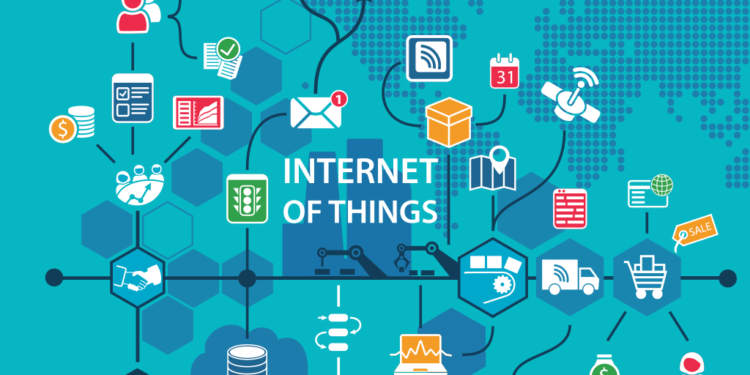A network of networked computing devices, mechanical and digital machines, items, or people with unique identifiers (UIDs) and the capacity to transport data across a network without the need for human-to-human or human-to-computer interactions is known as the Internet of Things (IoT).
A thing in the IoT can be any natural or artificial object that can be given an Internet Protocol (IP) address and can transfer data over a network, such as a person with a heart monitor implanted in them, a car with built-in sensors to warn the driver when tire pressure is low, or any other example. A blockchain development company is absolutely necessary for the growth of businesses and the operation of organizations. Particularly in an environment dependent on the internet,
IoT is being used by businesses across a range of industries to help them run more efficiently, better understand their consumers provide better customer service, improve decision-making, and increase the value of their operations.
Why do IoT networks need blockchain technology?
In this era of quick technological change, IoT is having a huge impact on gathering all of the devices and objects in the world and connecting them to the internet. The transaction-oriented data that goes along with it is what makes the Internet of Things successful. IoT security is essential since information is the key to the technology.
Any information breach or data theft not only renders IoT devices useless but also poses a risk to people’s lives or property. As a result, it’s important to protect IoT by guaranteeing accurate data and information security.
Currently, all the data is gathered in one location to guarantee the accuracy of IoT data. This creates a single point of security intelligence and, subsequently, a single point of failure, both of which are very dangerous.
By enabling IoT device networks to create an efficient security mechanism through which these devices can be allowed to form consensus for identifying what is expected within a given network and thereby isolating any nodes over a blockchain that behave unusually, a decentralized approach to IoT networking has the potential to eradicate the single point of failure in decision-making. Additionally, by facilitating digital security fundamentals like availability, responsibility, confidentiality, and integrity, blockchain can increase confidence in IoT data.
How can IoT be secured using blockchain?
We can use blockchain to secure Internet of Things devices.
Due to the distributed client/server model used by the Internet of Things (IoT), a network administrator is required to manage the network. The weakness in IoT cybersecurity is centralized authority. IoT devices rely on this permission to set limitations on how they typically operate.
The information provided by the devices is mostly at the mercy of hackers if the security of the central authority is compromised. Attacking the central authority is particularly alluring to cybercriminals since it allows for the collection of massive amounts of data all at once.
Because blockchain technology is decentralized, hackers would need to deliberately target network nodes in order to access the desired data. In a blockchain network, smart devices can actively take part in transaction validation.
As a result, the network may defend itself against a hack by monitoring any departures from predefined “accepted” behavior. Once a network device has been recognized as acting improperly, it can be isolated to stop it from, among other things, accessing more sensitive data or being used to unlock a person’s home.
Keep Physical Theft at Bay
Theft of smart devices could be avoided with the usage of Blockchain to safeguard IoT deployments. When a smart device is reported as stolen to the IoT blockchain network, it may be quarantined and its vital information may be given to the authorities, owners, etc.
Information like the smart device’s current position and even private images of the operator might be immediately provided to the closest police officers without requiring the involvement of a third party.
The operating system provider, other application platforms, and other businesses might instantly get the device’s distinctive manufacturer number and blocklist it. It would put an end to the practice now used by fraudsters who simply perform a factory reset and use the gadget for their own purposes.
Ensure the IoT environment you create is reliable.
Users must provide a special key code to access a blockchain ledger, which implies that accountability is included in all interactions and transactions.
Users must sign any modifications so that the person who made them may be identified. Because none of the other nodes linked to the network will accept the update, the network will prevent any unauthorized changes.
In the public sphere, schools or colleges may employ an IoT system based on blockchain to monitor student attendance and homework completion. Parents may be able to access the school blockchain to see their children’s progress through a vetted smart app.
Parents would be able to encourage and reward their children in real time if teachers were able to offer feedback and report any wrongdoings. This technique might also put an end to those dreary parent evenings that teachers, parents, and children detest.
The Challenges of Building IoT Networks Based on Blockchain
When creating blockchain-based IoT solutions, a number of technical difficulties appear. Here are a few of them:
Issues with scalability and storage capacity
Blockchain scalability and storage capacity have received a lot of attention. In this technique, copies are kept among network nodes and the chain is continuously developing. Despite the fact that only full nodes (nodes that are capable of completely validating transactions and blocks) store the entire chain, there is still a significant need for storage. Nodes lose capacity as they expand in size because they need more resources. A long chain also reduces performance by making it harder for new users to synchronize.
Security concerns
Numerous security flaws and threats have been discovered after a thorough analysis of the Bitcoin system. The majority assault, commonly referred to as the 51% attack, is the most frequent sort of attack that can occur if one blockchain participant holds more than 51% of the mining power. They are in charge of the network consensus in this instance. The integrity of Bitcoin may be in danger as a result of this attack due to the mining pools’ rapid expansion and development.
While inadequate data encryption can be another issue. A key element of data security and a fundamental aspect of blockchain technology is encryption. Unfortunately, IoT devices do not engage with consumers to produce trustworthy cryptography.
Legal problems
Implementing rules and compliance into a transaction is not simple. Enterprise-grade blockchain implementations will have to deal with a wide range of regulatory and legal challenges; while some of these structures have a long history, others are essentially unknown ground. One of the biggest of these barriers is the lack of clarity surrounding the monetary legislation and policy relating to digital currencies or cryptocurrencies. Although some nations and regulatory structures are moving closer to or further away from the blockchain industry, there are existing legal ambiguities over data ownership, privacy, access, and other issues in the IoT field. Interoperability
In the IoT era, it might be difficult to precisely and reliably join numerous networks. Despite the fact that distributed ledgers are designed to give shared data visibility, blockchain is not a solution for data integration. Interoperability, meanwhile, becomes more difficult in the world of blockchains due to factors like combining public and private blockchains, combining various open-source platforms, and combining already installed hardware, software, and data sets, among others.
Further limiting the technology’s capacity to coexist with other systems and counterparties are customization needs. Standardization is lacking at most stack layers, let alone at the process level or across industries or regions, despite being a primary objective of many joint ventures.
Conclusion
By enabling data integrity, decentralization, and smart contracts, fundamental blockchain technologies can enhance the functionality and security of IoT networks. Technologies like blockchain and the Internet of Things (IoT) are continually developing, solving old issues while creating new ones. As a result of their convergence, there are a number of concerns that developers should take into account, such as restricted IoT resources, scalability problems, and inadequate data encryption.






